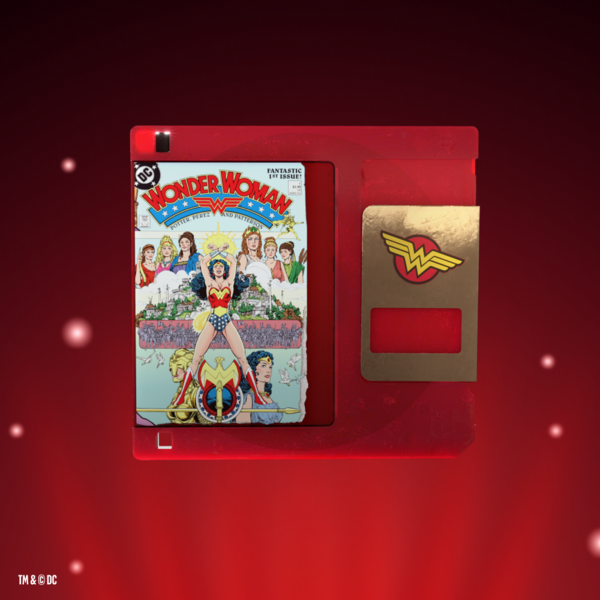
As part of the very successful marketing event DC FanDome last month, everyone who signed up was able to get a free DC themed NFT. Not wanting to be left out of the fun - and after making sure that at least these were lower energy, proof of stake NFTs - I signed up to get mine just to see what all the fuss was about.
The illustrations of the NFTs were not terribly exciting. Some classic DC covers displayed on... a 3.5 inch floppy disk. This form of data storage – 120 mb! - was common in the 90s but phased out by CD-roms early in this century. Depicting an ultra-modern NFT as a form of obsolete storage was obviously some kind of joke...but then so are NFTs.
Yes, yes, whatever humans attribute value to becomes valuable. An NFT is no more intrinsically worthwhile than a piece of paper with a picture of Benjamin Franklin on it. It's all a symbolic representation of something we agree to value. But the entire digital era of files copied from a floppy to a CD to to thumb drive to cloud storage is based on the idea of endless reproduction, the exact opposite of scarcity and ownership.
When NFTs got hot earlier this year, most people found the whole notion ludicrous, at first. The idea of owning any kind of digital file goes against all the copying and pasting we do in our days of data drudgery. But there was money involved - lots of it - and bored people stuck at home on COVID shopping sprees with lots of virtual currency and no place to spend it, and the idea took off.
The pushback has been and remains huge. The problem with NFTs is about sustainability: the energy used to compute digital codes that are so huge that they can't be copied (that's my layman's explanation). In order to assuage some of the guilt over destroying more of the environment, many people tried to find ways to use the blockchain in more socially beneficial ways. This was the second energy splurge of the NFT era: believers trying to convince skeptics it wasn't all bad.
Last winter and spring, when things were red hot, I had many phone calls and emails and zooms with people trying to convince me that NFTs would be a boon for artists and creatives, supporting a system of irrefutable ownership and indestructible contracts.
They weren't entirely wrong: NFTs have certainly been a boon in that artists are now making a lot of money creating art for this scheme. And it is a scheme. When you cut through all the baffle gab that inevitably surrounds any of these discussions, NFTs are just another con job, with people at the top skimming off the profits. But hey, inflation is here and we could all use some extra dough. Let the artists get paid in regular old cash with conventional bank transfers.
I've yet to see any real way that NFTs will benefit artists aside from maybe making it easier to get a portion of the sale price when a piece of digital art is "sold." But I'll confess, I don't spend all day researching it, either. I've heard a lot of arguments and I've yet to be convinced. And Iim not alone. Even the guy who helped invent NFTs, Anil Dash, isn't convinced.
We took that shortcut because we were running out of time. Seven years later, all of today's popular NFT platforms still use the same shortcut. This means that when someone buys an NFT, they're not buying the actual digital artwork; they're buying a link to it. And worse, they're buying a link that, in many cases, lives on the website of a new start-up that's likely to fail within a few years. Decades from now, how will anyone verify whether the linked artwork is the original?
All common NFT platforms today share some of these weaknesses. They still depend on one company staying in business to verify your art. They still depend on the old-fashioned pre-blockchain internet, where an artwork would suddenly vanish if someone forgot to renew a domain name. "Right now NFTs are built on an absolute house of cards constructed by the people selling them," the software engineer Jonty Wareing recently wrote on Twitter.
That's right: your digital purchase is just a link to a file somewhere, and nothing NOTHING AT ALL is stopping that link from going dead. This whole piece is a must read take down of the whole NFT idea, but obviously Dash struggles, as I do, with some well meaning people who are still trying to find the upside in the Ethereum.
And that brings us back to my DC NFTS! After registering, I got an email with a code which I redeemed on the FanDome site. And then I waited for my NFT to be minted. (Oh the gas fees!) And then on one happy day, I got an email saying my NFT was ready.
Logging in to the DC NFT site, I eagerly unwrapped my new, one of a kind artwork...an mp4 of a spinning floppy disk with a Dan Jurgens cover on it. With a contract address and a Token ID that conferred ownership. Sort of. The DC NFTS are stored in a "wallet" somewhere, (see above) so the thing I actually own is somewhere out there on the blockchain in the great metaverse of ideas.
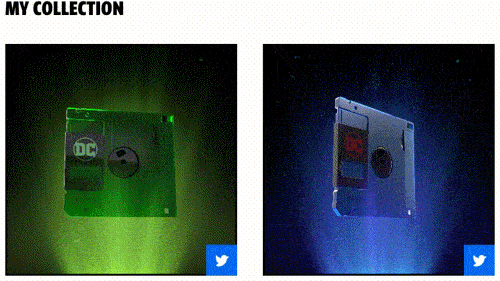
In the words of Peggy Lee, is that all there is?
But that was not all there is!
It turned out, I could get a SECOND DC NFT by tweeting about the first one! I didn't actually mean to do this, since the exhaustion and energy consumption of owning one NFT was quite enough for one day. But when I clicked on the Twitter logo, the site thought I had actually tweeted (I didn't) and started minting my second one.
One to own, one to trade! After a few days, I checked back and sure enough there was my second NFT, a classic Neal Adam Green Lantern/Green Arrow cover on a spinning floppy disk.
So yeah. I'm the proud owner of these gen-yoo-wine DC non-fungible tokens. I'm going to have some people over to the house to show these off. Wine and cheese will be served!
This all happened a few weeks ago. As my inbox fills up daily with PR about this or that new NFT release, I kept thinking about my little collection and the damn floppy disk. That had to mean something, right?
It turns out I had missed a key clue on the FanDome website.
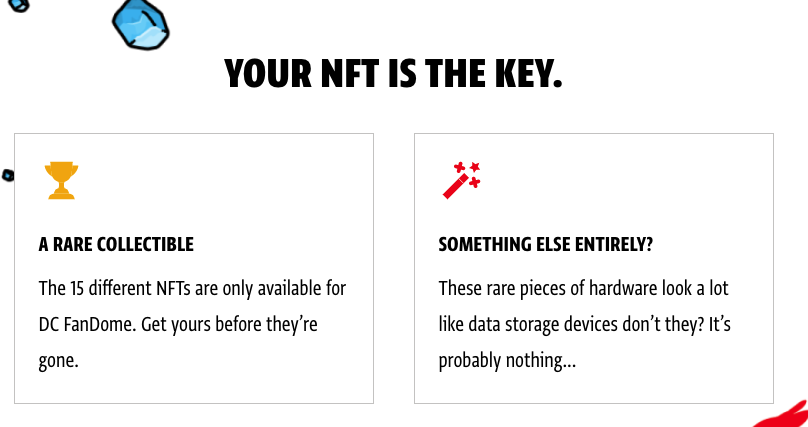
"Probably nothing." So was there more to these NFTs? What is inside that floppy?
Doing a little digging, I found that to make all these NFTs, DC partnered with Palm, a newish NFT studio that runs on Etherium, one of the major blockchain platforms that turns out the Eth currency. Or as the website puts it:
Palm is a new NFT ecosystem for culture and creativity, built efficiently with Ethereum. The Palm ecosystem features low gas costs, fast transaction finality, and is over 99.9% more energy efficient than Proof of Work systems.
According to the FAQ:
How is Palm a more environmentally friendly platform for NFTs? Blockchain networks based on Proof of Work mining consume a lot of energy. This is by design, as the energy expended to process transactions is part of the security model that protects the network from would-be attackers. Palm uses a different security model that ditches the high energy consumption and instead relies on a pool of known validators to secure the network from malicious third parties. While mainnet Ethereum has plans to phase out Proof of Work mining over time to a more environmentally friendly mechanism called Proof of Stake, Palm provides an immediate solution to the ecosystem that allows eco-conscious artists and brands to dive into the world of NFTs without the heavy environmental footprint.
There's more about crossing over the Palm bridge, but like I say, any time people try to explain this, the jargon piles up. That's part of the whole psychology of the con.
It turns out that my two NFTs are (sob sob) COMMON. Palm and DC minted some 800,000 NFTs for Fandome attendees. But there were three levels of rarity. According to an AMA with Palm's chief creative officer, the ratio was 65% common, 32% rares, and 3% legendaries.
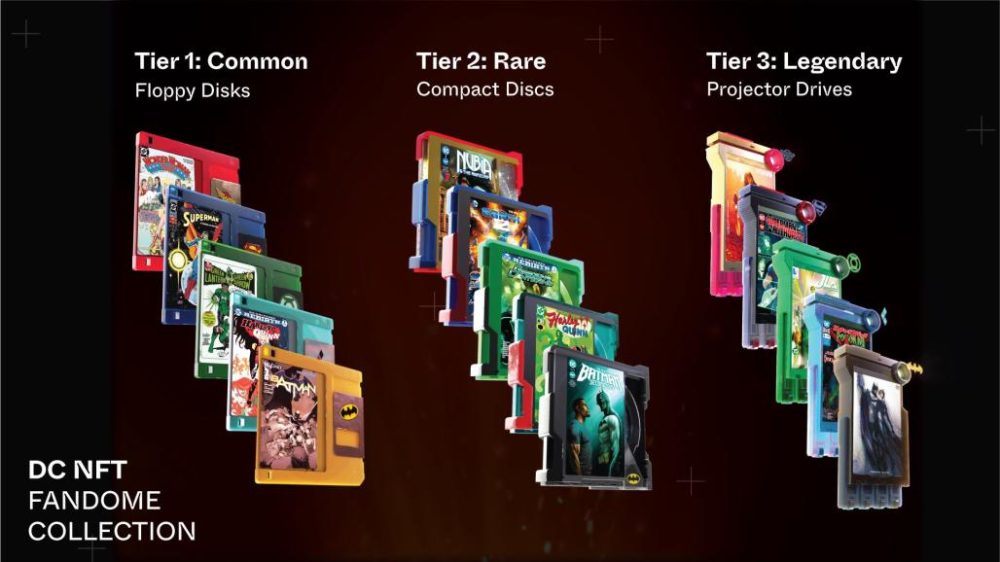
It turns out not all DC NFTS come on a floppy disk! Rares come on a "compact disc" and legendaries on the lordly "projector drive." I like to think I know my antique data storage media, but I don't recognize these. A "compact disc" is a CD, that flat shiny thing you put in your obsolete CD players. Palm's "compact disk" looks more like a Syquest drive, but not exactly...I guess I missed that one. I have no idea with a "projector drive" is so you can all school me in the comments. It looks like an inkjet printer cartridge that projects images like R2-D2 and whatever they were used for must have been buck wild.
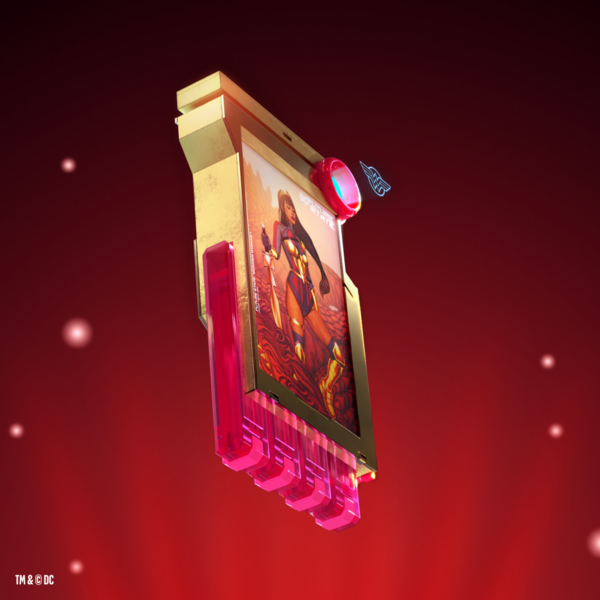
And Palm recently ginned up more curiosity with another tweet about the secret "inside" the NFTs.
The rarity levels - and mystery about the NFT secret message - has led to a lot of speculating about future speculation for these collectible digital tokens. Over on the Palm discord, people are eager to sell them and live off the proceeds for the next decade or so. As for the secret, some have guessed that each image has a code and someone figured out it spells "DC Infinite Earth" - so this would seem to be some kind of "Drink More Ovaltine" moment promoting a DC property. More to come, as we like to say.
Will these ever be worth anything? Most DC NFT owners are eager to start selling and trading, but that won't be allowed until early next year. People who have vouchers can still redeem them until January 22nd, after which the market will open up. They're anxious about crossing the Palm bridge and missing the airdrop and whatever. Step three: Profit!
Is it all a bit silly? Of course. But so is infusing a fragile comic book or a Mike Trout baseball card with monetary worth. It's all a marketplace of the mind. A daydream. Supply and desire.
So where did I end up on all this? For one thing, I won't be selling my NFTs. I don't want to get any further in on the con - I feel crappy enough about going this far in. My own recurring daydream stems from the knowledge that pandemic era of zooms and chats and the looming Metaverse is a lot less vibrant and memorable than then real, tangible world. I miss that world. I like looking at a piece of original art and seeing the hand and mind of the artist in it. The value of that is equally intangible, but so beyond a price. Is there really some kind of infinity in this massive, endless code? Maybe the edgelord Johnny Mnemonics who are buying and selling things on the blockchain are onto something, a digital recreation of our own drifting attention span.
Or maybe it's just a scam all the way. At least I still have my spinning disk gif and whatever it represents. My piece of digital art sits in a wallet somewhere, which, as Dash pointed out, can vanish with one startup failure, just as floppy disks and Syquests are unreadable now. This whole intangible moneymaking fad is just what these days demand, art as abstract, digital codes for an alienated, conflicted time.







No comments:
Post a Comment